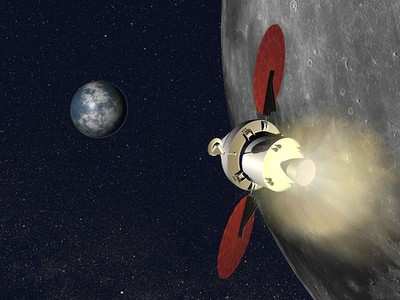Mon, Nov 28, 2011
Design Verification Testing Completed On First MR-104G Engine
For NASA's Orion Spacecraft
Aerojet said Tuesday it has successfully completed vibration,
shock and hot fire design verification testing on its first MR-104G
monopropellant rocket engine planned for use on NASA's Orion
spacecraft. The testing was done in conjunction with Lockheed
Martin and NASA. Twelve 160-lbf thrust MR-104G engines, arranged in
four single-engine pods and four dual-engine pods, provide the full
complement of primary and redundant control required for critical
maneuvers upon a high-speed re-entry into Earth's atmosphere.
MR-104G Engine

The first phase of the MR-104G design verification testing was a
critical milestone in the development of the Orion Crew Module
propulsion system and marks a significant step toward Orion's first
orbital flight test. Orion-specific environment, performance and
life requirements were demonstrated as part of this test program in
support of the flight test plan. The design verification testing
program consisted of vibration and shock testing to appropriately
stress the engine structure and catalyst bed similar to launch
environments prior to engine hot fire testing. The hot fire test
then demonstrated the engine performance and life capability, along
with thermal model validations with cold starts, hot restarts and
deep thermal cycles.
Several new design features for the MR-104G engine were
demonstrated in this testing series, including a newly developed
120-volt series-redundant propellant valve, a 120-volt/40 watt
catalyst bed heater, a new chamber pressure transducer and an
integral thruster mount configuration.
NASA Image

The MR-104 engine family originally provided in-space propulsion
for the Voyager 1 and 2 and Magellan missions. Subsequent MR-104
variants provided propulsion for Landsat, NOAA as well as other
U.S. government programs.
"Aerojet is very proud of its support of the crew module's
liquid propulsion systems for the Orion spacecraft," said Sam
Wiley, Aerojet's Orion program director. "We are excited to provide
spacecraft propulsion engines to be used for the next generation of
human spaceflight and continue our track record of 100 percent
mission success for NASA's human spaceflight dating back to
Apollo."
More News
The Industry Continues to be Rocked By Some Questionable Operations Recent investigations and a great deal of data has resulted in ANN’s SportPlane Resource Guide’s rep>[...]
Make Sure You NEVER Miss A New Story From Aero-News Network Do you ever feel like you never see posts from a certain person or page on Facebook or Instagram? Here’s how you c>[...]
Visual Approach Slope Indicator (VASI) An airport lighting facility providing vertical visual approach slope guidance to aircraft during approach to landing by radiating a directio>[...]
Airport Marking Aids Markings used on runway and taxiway surfaces to identify a specific runway, a runway threshold, a centerline, a hold line, etc. A runway should be marked in ac>[...]
Aero Linx: The Skyhawk Association The Skyhawk Association is a non-profit organization founded by former Skyhawk Pilots which is open to anyone with an affinity for the A-4 Skyhaw>[...]
 Unfortunate... ANN/SportPlane Resource Guide Adds To Cautionary Advisories
Unfortunate... ANN/SportPlane Resource Guide Adds To Cautionary Advisories ANN FAQ: Turn On Post Notifications
ANN FAQ: Turn On Post Notifications ANN's Daily Aero-Term (04.29.24): Visual Approach Slope Indicator (VASI)
ANN's Daily Aero-Term (04.29.24): Visual Approach Slope Indicator (VASI) ANN's Daily Aero-Term (04.28.24): Airport Marking Aids
ANN's Daily Aero-Term (04.28.24): Airport Marking Aids ANN's Daily Aero-Linx (04.28.24)
ANN's Daily Aero-Linx (04.28.24)




